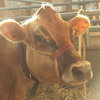No fowl at the fair
Enterprise file photo — Melissa Hale-Spencer
Displaying her knowledge and her bird for a judge, Marcy Forti of Knox has competed for years at the Altamont Fair. This year, there will be no poultry competition at the fair; the state is banning all live fowl competitions because of avian flu in other parts of the country.
GUILDERLAND — Because of avian flu in the other parts of the country, New York’s Department of Agriculture and Markets announced Tuesday the state is banning all live fowl competitions.
“It’s very disappointing,” said Jeffrey L’Arche, the poultry superintendent for the Altamont Fair. “I hope it’s just temporary, just for one year.”
The August fair, which serves Albany, Greene, and Schenectady counties, in recent years has displayed 800 to 1,000 birds, including chickens, ducks, guinea hens, and geese, in its poultry barn. The fair has also held judging competitions for youth.
L’Arche said on Tuesday afternoon he was not “terribly surprised” by the ban and can understand the state wanting to be proactive.
“This really hits us,” said Amy Anderson, manager of the Altamont Fair, on Wednesday. “We have an entire building dedicated to poultry. She also said, because of the ban, there will be no baby chicks or baby ducks in the Agriculture and Science Building.
“We’re putting on our creative thinking caps,” Anderson said of how to fill the void. One idea, she said, is to use the poultry barn for displays from wildlife rescue agencies. Any ideas from the public would be welcome, she said, and can be emailed to the fair office: [email protected].
“It’s breaking our hearts,” Anderson concluded. “We love having our birds.”
The current influenza outbreak while deadly to birds does not affect humans, according to a release from Agriculture and Markets; the outbreak, concentrated in two strains — H5N2 and H5N8 — has been found on more than 170 farms in 20 states in the West, Midwest, and South and in two Canadian provinces. Officials have called it the largest avian influenza outbreak in United States history, with over 35 million birds dying or being euthanized.
“Avian influenza has not yet been detected in New York State, but it is a very serious threat to poultry and all breeds of fowl and is continuing to spread,” said New York’s commissioner of agriculture, Richard Ball, in a statement. “Despite the efforts of the best poultry health experts in North America, we do not fully understand the cause of the rapid spread of this virus.”
Food safety experts recommend properly handling raw poultry to protect against food-borne illness, and cooking chicken to an internal temperature of 165 degrees.
L’Arche said, in the past, he has ordered baby chicks from a hatchery in Iowa, Murray McMurray Hatchery, that hatches 10,000 chicks a day, from March to September.
He said it would be sad to forgo the fair’s baby chick project. “It’s always been a favorite,” he said. Chickens take 21 days to hatch and they are started, under incubation, so that some of them hatch each day of the fair.
“In the old days at the Altamont Fair,” L’Arche said, “there would be 5,000 to 10,000 birds. They used to have string men who would load birds on railroad cars or flatbed trailers and go from one fair to another.” In recent years, he said, most of the exhibitors at the fair are local and many of them are youth who raise their birds in 4-H programs.
L’Arche, 66, raised birds in his youth. He grew up on Willow Street when it was still quite rural. “There were chicken coops behind most the houses,” he said. L’Arche would care for neighbors’ chickens when they were away. “I feel like Rip Van Winkle,” he said, when he visits Willow Street now. “So much has changed. It was a wonderful way to grow up, close to agriculture.”
His Willow Street neighbor, the late Richard Langenbach, longtime poultry superintendent at the Altamont Fair, introduced him to the art and science of raising birds. “Dick was my poultry mentor,” said L’Arche.
L’Arche, who celebrated his 40th year as a priest on Sunday, keeps his birds at La Salette, on the hill above Altamont where he lives. He has about 200 birds — standard chickens; bantam chickens; guinea hens from Africa, which he said are good for tick control; and doves.
He doesn’t let them loose because there are “too many varmints,” he said, naming hawks, foxes, skunks, raccoons, and possums.
“All show birds have to be tested,” L’Arche said. “You need a certificate from Ag and Markets, saying they are pullorum-free.”
L’Arche believes an empty poultry barn this August will hurt the central mission of the Altamont Fair. “The fair’s focus is to celebrate the bounty of the land,” he said. “And the competition makes for better specimens; it improves food sources.”
L’Arche went on, referring to Donald Wininski, “There’s a disconnect in contemporary society between the source of food and those who consume it. Brother Donald taught a class where he asked the children where eggs come from. Some said, ‘Eggs come from the store.’ Some said, ‘The eggs come out of their beaks.’”
L’Arche said there are kids now, raising their birds from chicks, expecting to show them at the fair. “As a kid, it would be very disappointing,” he said, to not have a place to show them.
He believes the ban is a needed precaution, though. “People should understand because they want to protect their birds.”
Updated on May 20, 2015, to include comments from a May 20 interview with fair manager Amy Anderson.


